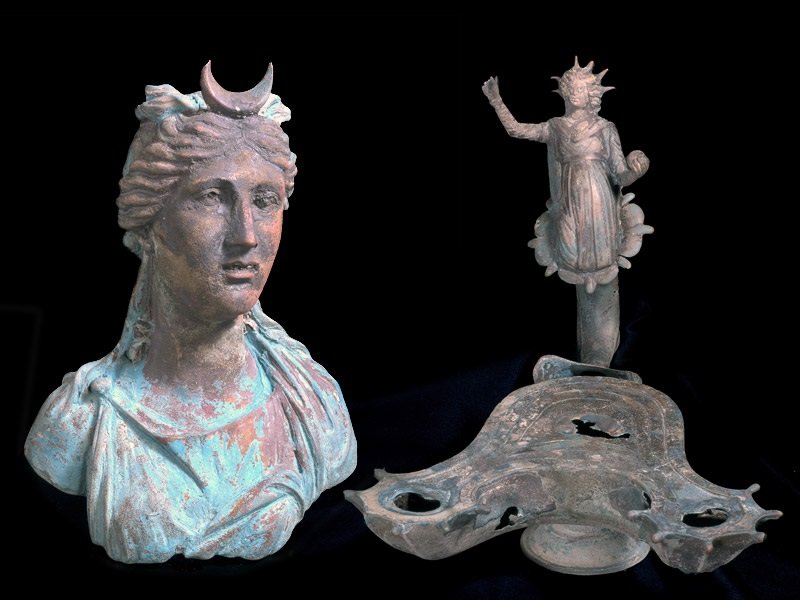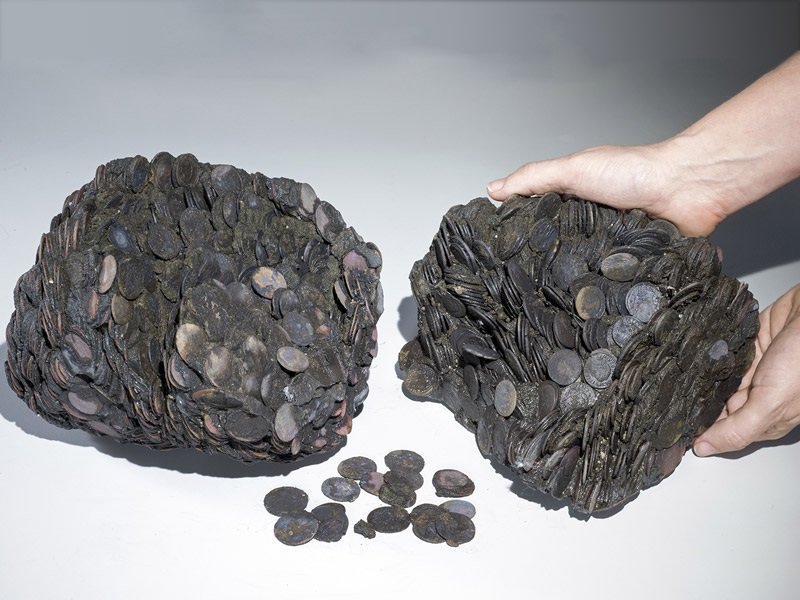
A fortuitous discovery by two divers in the ancient port of Caesarea in the Caesarea National Park before the Passover holiday led to the exposure of a large, spectacular and beautiful ancient marine cargo of a merchant ship that sank during the Late Roman period 1,600 years ago.
As soon as they emerged from the water divers Ran Feinstein and Ofer Ra'anan of Ra'anana contacted the Israel Antiquities Authority and reported the discovery and removal of several ancient items from the sea.
A joint dive at the site together with IAA archaeologists revealed that an extensive portion of the seabed had been cleared of sand and the remains of a ship were left uncovered on the sea bottom: iron anchors, remains of wooden anchors and items that were used in the construction and running of the sailing vessel. An underwater salvage survey conducted in recent weeks with the assistance of many divers from the Israel Antiquities Authority and volunteers using advanced equipment discovered numerous items that were part of the ship's cargo.
Many of the artifacts are bronze and in an extraordinary state of preservation: a bronze lamp depicting the image of the sun god Sol, a figurine of the moon goddess Luna, a lamp in the image of the head of an African slave, fragments of three life-size bronze cast statues, objects fashioned in the shape of animals such as a whale, a bronze faucet in the form of a wild boar with a swan on its head, etc.
In addition, fragments of large jars were found that were used for carrying drinking water for the crew in the ship and for transportation at sea. One of the biggest surprises in particular was the discovery of two metallic lumps composed of thousands of coins weighing c. 20 kilograms which was in the form of the pottery vessel in which they were transported.
This discovery comes a year after the exposure of a treasure of gold Fatimid coins by divers and the Israel Antiquities Authority, which is currently on display for the public in the "Time Travel" presentations in the Caesarea harbor.
According to Jacob Sharvit, director of the Marine Archaeology Unit of the Israel Antiquities Authority and Dror Planer, deputy director of the unit, "These are extremely exciting finds, which apart from their extraordinary beauty, are of historical significance. The location and distribution of the ancient finds on the seabed indicate that a large merchant ship was carrying a cargo of metal slated recycling, which apparently encountered a storm at the entrance to the harbor and drifted until it smashed into the seawall and the rocks".
A preliminary study of the iron anchors suggests there was an attempt to stop the drifting vessel before it reached shore by casting anchors into the sea; however, these broke - evidence of the power of the waves and the wind which the ship was caught up in". Sharvit and Planer stress, "A marine assemblage such as this has not been found in Israel in the past thirty years. Metal statues are rare archaeological finds because they were always melted down and recycled in antiquity.
When we find bronze artifacts it usually occurs at sea. Because these statues were wrecked together with the ship, they sank in the water and were thus 'saved' from the recycling process". Sharvit and Planer added, "In the many marine excavations that have been carried out in Caesarea only very small number of bronze statues have been found, whereas in the current cargo a wealth of spectacular statues were found that were in the city and were removed from it by way of sea.
The sand protected the statues; consequently they are in an amazing state of preservation - as though they were cast yesterday rather than 1,600 years ago". The coins that were discovered bear the image of the emperor Constantine who ruled the Western Roman Empire (312 - 324 CE) and was later known as Constantine the Great, ruler of the Roman Empire (324 - 337 CE), and of Licinius, an emperor who ruled the eastern part of the Roman Empire and was a rival of Constantine, until his downfall in a battle that was waged between the two rulers.

They will be awarded a certificate of appreciation and invited to tour the storerooms of the National Treasures. By reporting the discovery of the marine assemblage to the Israel Antiquities Authority they have made it possible for all of us to enjoy these spectacular remains from antiquity. The public should be aware that it must report any artifacts it finds immediately to the Marine Archaeology Unit of the Israel Antiquities Authority in order to maximize our archaeological knowledge about the site".
While the new finds are still undergoing conservation treatment and are being studied by the Israel Antiquities Authority, the cache of gold coins that was discovered in the water off of Caesarea in the winter of 2015 is already being displayed to the visiting public in the Caesarea harbor as part of the experiential presentation entitled "Time Travel".
The director-general of the Caesarea Development Corporation, Mr. Michael Kersenti, notes that the recent discoveries reiterate the uniqueness of Caesarea as an ancient port city with a history and cultural heritage that continues to surprise us, when other parts of the mysteries of its past are revealed in the sea and on land. The goal is to present as many of the cultural treasures as possible, including those that will be discovered in the future, to the numerous visitors who come to Caesarea each year.
Additional Historical Background:
According Sharvit and Planer, "The range of finds recovered from the sea reflects the large volume of trade and the status of Caesarea's harbor during this time, which was known as period of economic and commercial stability in the wake of the stability of the Roman Empire.
The crew of the shipwreck lived in a fascinating time in history that greatly influenced humanity - the period when Christianity was on its way to becoming the official religion of the Roman Empire.
It was at this time that Emperor Constantine put a halt to the policy of persecuting Christians, and the faithful in Caesarea, as well as elsewhere in the Roman Empire, were given the legitimacy to practice their belief through the famous Edict of Milan that proclaimed Christianity was no longer a banned religion. Later, Christianity was recognized as the official state religion, and it was during Constantine's reign that the fundamentals of the religion were established.



[Link]